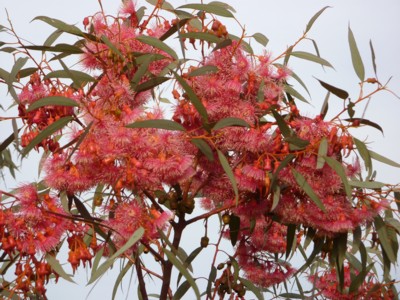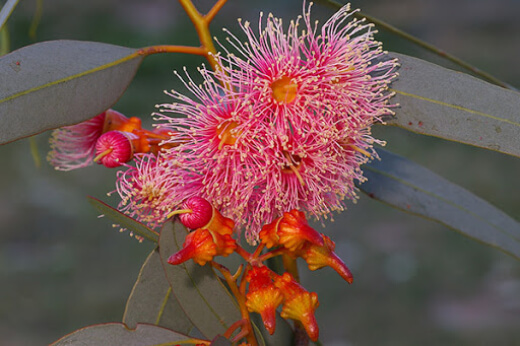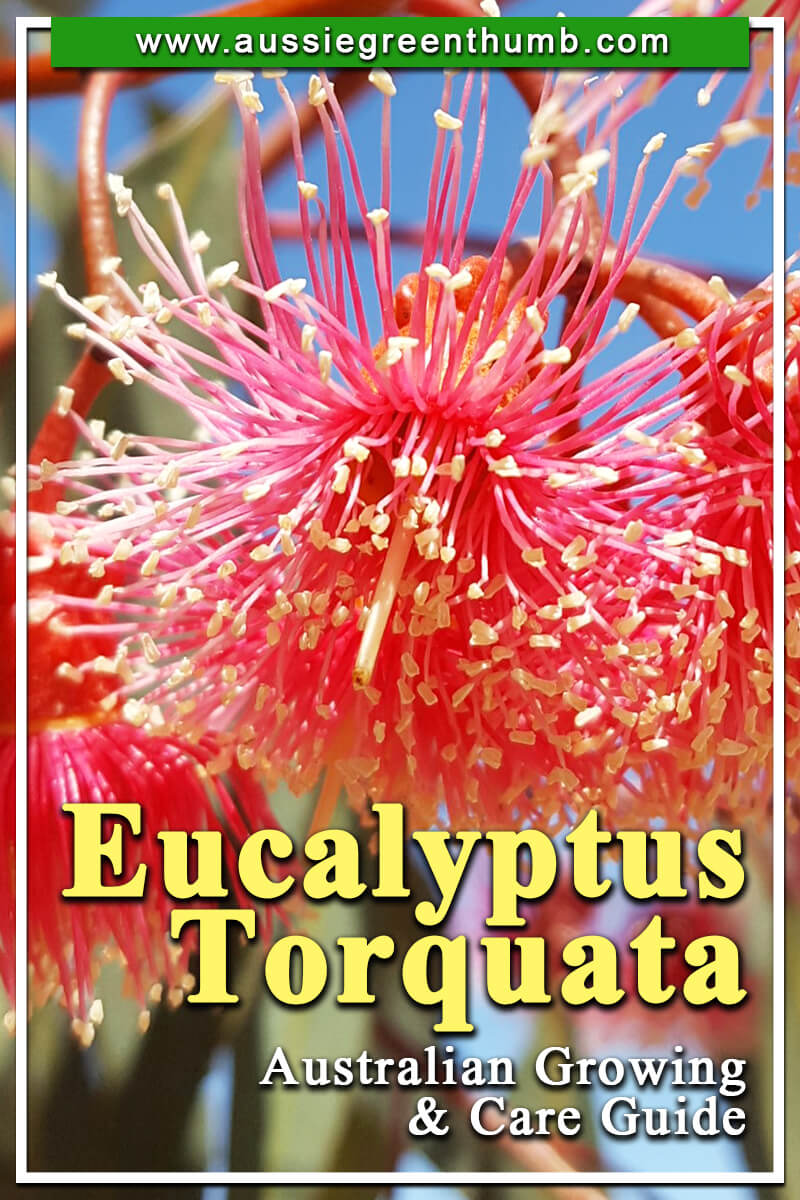Looking for a garden plant, with fabulous, fragrant foliage and a fast growth rate? When in bloom, the Eucalyptus torquata really is something to behold. It’s hardy and practically pest and problem free, with countless residential and commercial landscaping applications.
Pretty and perfect for beginner growers here’s what you need to know about growing Eucalyptus torquata in your home.
More...
What is Eucalyptus torquata?
Family: Myrtaceae
Genus: Eucalyptus
Species: E. torquata
Common Name: Coral Gum or Coolgardie Gum
Flower Colour: Pink
Foliage Colour: Green
Growth Habit: Small Tree
Flowering: Spring

If you want a pretty perennial for your patio space or garden, look no further than the Eucalyptus torquata or also known as the Coral Gum Tree.
How to Grow Eucalyptus torquata
Coral gum trees are fairly easily cultivated and once established will be largely hassle-free. However, it’s important to make sure you give your Coolgardie gum the right conditions in which to prosper.
The Eucalyptus torquata tree grows best when it gets lots of direct sunlight, which makes it un-ideal for indoors. You can grow this species in a pot, however, it is known to have fast-growing roots, so you’ll want to ensure your pot has plenty of space.
A key factor for eucalyptus plant health is well-draining soil. Waterlogged roots can cause a major issue. Clay, loam and sandy soils are all suitable for this species. You’ll want to maintain a higher alkaline soil pH level.
Growing Eucalyptus torquata from Seeds
Growing from a seed is your best bet when it comes to eucalyptus trees. While you can harvest seeds directly from a tree, it’s hard to tell which seeds are dormant. It’s recommended to rather buy your seeds to ensure that they’ll germinate.
Sowing of seeds should be carried in spring or autumn.
Here’s how best to sow your seeds:
- Clean and sterilize your seeding tray and then fill with a well-draining, porous seeding mix.
- Pour your E. torquata seeds onto your hand and sprinkle onto the surface of your soil. It’s important that your seeds remain uncovered initially.
- Water with a good amount of water so the seeds are able to lodge into the pores of the soil.
- Keep the seedling tray in a warm, shaded or semi-shaded spot.
- Keep soil moist by means of a mister so as not to disturb the seeds.
- Transplant once your seedling has produced at least one true leaf.
Take extreme care when transplanting so as not to damage any roots. Treating the soil in your garden or pot before planting is recommended.
Adding an extra-phosphorous fertiliser to the soil will help to stimulate root growth. Transplanting should be carried out in late fall, winter or early spring.
Can You Grow Coral Gum from a Cutting?
While growing from a cutting is possible, it’s not advised for novice growers and only an option for those who like a challenge.
Here’s how you can grow coral gum from a cutting:
- Use a cleansed, sharp grafting knife to remove a cutting, about 10 cm in length. You’ll want to ensure your cutting has at least one budding leaf.
- Dip the cut end into rooting hormone for about 30 seconds and then stick straight into perlite mix, root-end down.
- Cover your cutting and pot in plastic and place in a warm spot.
- Keep your soil moist through regular misting.
Eucalyptus torquata Growth Rate
Once it gets going, your tree will grow quite quickly. Coral gum's growth rate is as much as 60cm per annum, which is quite a bit more than most trees.
Plus, this cultivar is known to live as long as 150 years, so your plant will grow big and beautiful for years to come.
How to Care for Eucalyptus torquata Coral Gum

Source: anpsa.org.au
When it comes to caring for your Eucalyptus torquata coral gum, the most important factors will be your watering, pruning and staking.
Watering
Watering is the most important aspect of the three. While it is a drought tolerant plant, the E. torquata is used to getting lots of winter rain.
You’ll also want to ensure your Coolgardie gum gets enough water in the summer months, if rain is scarce. In its first two years of growth, water at least twice a week.
Once your tree is better established you can cut back and only water in particularly dry seasons.
Pruning
Pruning is a vital part for any plant. It’ll help you to maintain your coral gum tree’s size and shape as well as stimulate vigorous growth. A solid cut back can be undertaken during the winter months.
Should you find any dead or droopy branches, you can remove these at any time with an electric or hand-held saw.
To help you in your pruning, be sure to check out our review on the best electric pole saws for 2024.
Staking
It is advisable to stake your tree while it is still young. Once planted you can simply secure the base of the trunk to a stake. Once your tree is strong enough, just remove the stake.
You won’t need to spend much time fertilising your tree; however, it is recommended to add some occasional slow-release plant food during the growing stages of its first few years. Thereafter, you can cut back entirely.
Your coral gum should begin to bloom after its first growing year and generally blooms throughout most of spring, summer, autumn and sometimes even winter.
Should you notice brown or withered flowers, simply cut them off with a sharp pair of shears.
Potential Pests & Diseases
Eucalyptus trees are known to be quite hardy and not overly susceptible to pests and diseases. E. torquata cultivars are resistant to verticillium wilt, however it’s good to keep an eye out for potential rot.
Especially if your tree’s roots have been particularly waterlogged. Another one to keep an eye out for is beetle borers and phytophthora. Both can be treated, however, with natural insecticides or fungicides respectively.
Eucalyptus torquata Tree Uses
As mentioned, this striking tree has plenty of landscaping applications. They are beautifully fragrant and aesthetically appealing, which makes them ideal for in planters on patios or as part of your garden.
Consider adding your Coolgardie gum into raised planters or use it as a flowering accent plant. The Coral Gum even makes for a great screening plant when pruned correctly.
Plus, this pretty plant provides plenty of shade so along a pool or as a garden-lining tree is also ideal. While the medicinal benefits of Eucalyptus trees are well known, there are no specific, known benefits to this species.
Eucalyptus torquata Frequently Asked Questions
What are other names for Eucalyptus torquata?
E. torquata is known by a few different names, but most commonly, the Coral gum tree or Coolgardie gum, thanks to its effervescent coral coloured flowers that form into spiked pompoms similar to many species of coral native to Australian waters.
How quickly does Eucalyptus torquata grow?
E. torquata grows incredibly fast at a rate of 1m per year, or more. This fast growth makes it an excellent garden plant as it can be grown as a low hedge with annual pruning, or allowed to quickly establish into a fully fledged tree, providing form and structure in around 5 years.
Can you plant Eucalyptus torquata near a house?
E. torquata has strong roots that can damage timber and stone structures, so plant it at least three times its final height away from the house, pools, or permanent structures.
Planted in pots, E. torquata is easy to contain, but it will grow slower and flower less readily.
Is Eucalyptus torquata native to Australia?
E. torquata is native to Western Australia, and commonly cultivated for garden use around the world, but still grows best here on our own shores.
Its seeds take easily in the sandy soils, particularly in southern Western Australia, where the heat helps to trigger germination making them incredibly common in nature.
How do you identify Eucalyptus torquata?
E. torquata is surprisingly simple to identify, even when it’s not in flower. Its clustered drooping, elongated leaves with their dull silver sheen are distinct from rounded-leaved eucalyptus, or willow-leaved varieties and their bright red tufted flowers are instantly recognisable.
Even in their dormant season when the stems are bare, the bark flakes, rather than peels like most Eucalyptus species.
Where is the best place to plant a eucalyptus tree?
The best place to plant a eucalyptus tree is in full sun, on well-drained soil. Soil nutrition isn’t particularly important to eucalyptus, so any sandy or reasonably drained loamy soils will do.
Try to protect eucalyptus from high winds where possible, whether that’s by using the house as shelter, or planting young trees with some protection from established plants.
When is the best time to plant eucalyptus?
Eucalyptus saplings are best planted in spring or early summer. This uses the natural rhythms of the plant to trigger instant root growth once planted.
The summer temperatures quickly help to establish the tree, but will also mean watering regularly for the first few months to prevent unestablished roots from drying out.
How to prepare the ground for planting Eucalyptus torquata?
E. torquata do require some preparation before planting, despite needing very little as mature plants. Before planting, dig a hole at least twice the size of the root ball, and loosen up the earth around the sides, and at the base.
Mix in plenty of organic material to add nutrition in support of young roots. Once the tree is established, there is little need to feed again.
Does Eucalyptus torquata require a lot of water?
E. torquata need regular water for their first two months in the garden. After that, they do not need watering at all. Tall eucalyptus are highly drought tolerant plants, and as natives to Western Australia can cope with our extreme summers without irrigation.
Can you grow Eucalyptus torquata in pots?
E. torquata can be a pretty big tree, but for smaller gardens and yards, it’s worth considering pot-grown eucalyptus trees. This will help to restrict their growth, but they will still need pruning every other year.
Each time you prune, remove entire branches, leaving the youngest branches to continue growing. This will help to maintain a more natural shape.
How do you make Eucalyptus torquata more bushy?
Like all eucalyptus plants, E. torquata can be pruned hard, right to the ground, or pollarded (back to the central trunk) every year if you like. This encourages intently bushy growth each year, with a shape and feel a little more like a Mediterranean olive.
Is my Eucalyptus torquata overwatered or underwatered?
Under watered eucalyptus trees are unlikely to be found as they are very drought tolerant, but when young, they can develop dark spots on their leaves and older leaves can fall early in the season.
Overwatering is much more common and causes yellow leaves, usually up one side of the tree, accompanied by wet soil.

Wrapping Up Our Eucalyptus torquata Growing Guide
So, there you have it. Everything you’ll need to know to perfectly cultivate, grow and care for your very own coral gum tree. When planting, ensure plenty of sun and free-draining soil for optimal growth.
Whether as a shade plant or decorative addition, you’ll enjoy having the bright and beautiful Eucalyptus torquata in your backyard.
Published on January 11, 2023 by Aussie Green Thumb
Last Updated on February 22, 2024






I could not find an answer to my query for why the flower buds ALL fall off without flowering. Every week I sweep up thousands of dropped buds. This Torquata tree is about 12yo and has always behaved this way.
Hi Jan,
I can understand your frustration with the constant blossom drop in your Torquata tree.
The flower drop phenomenon can be very disheartening and unfortunately, it is hard to discern exactly what may be causing this in your tree specifically as there are many possible reasons for this occurrence.
Firstly, the most likely cause is usually a lack of pollination in certain plants. If you notice your other vegetation is flowering and your Torquata isn’t, it could be that the tree simply isn’t being pollinated sufficiently to sustain flowers. A reliable solution would be to plant more herbs and flowers around the tree to turn the surrounding area into more of a pollination hotspot.
Drastic differences between high daytime temperatures and freezing night-time temperatures are also a common cause of flower drop, especially in young buds as you’ve described with your tree.
Typically, temperatures above 30°C or below 12°C can result in flower drop. You can try covering your tree in shade cloth for the heat and frost cloth during cold nights. Mulch can also help improve overall insulation.
Infertile soil is another common cause as the soil will not have enough nutrients to support new blossoms. If you think it may be your soil, I suggest testing the pH level of your soil and adjusting it as needed to be more balanced. Adding some organic materials to your soil is an excellent way to boost its nutrient content.
Lastly, thrips are pests that specifically target and feed on new flower buds. They are small in size with a long, flat shape and are usually white to brownish in colour. Try a natural pesticide to get rid of thrip infestations.
I hope you can identify the issue based on these common causes Jan and get your beautiful Torquata flowering prolifically in the coming seasons.
All the best from team AGT.
I live in northern Spain, in a usda climatic zone 9 or 9b under a temperate climate without hot temperatures ¿can i try to grow Eucalyptus torquata?
PS I grow a lot of australian plants like Banksias, Melaleucas, Eucalyptus, Hakeas, Dryandra and others but my limit seem to be lack of heat
Hi Jesus,
You shouldn’t have any problem growing Eucalyptus torquata there. Even if you get a frosty winter it’ll make it through easily. It’s a hardy plant that will grow well in much cooler climates than yours.
The main problem you might come across is getting it to establish if there are any dry periods in mid-summer. Plant it out either in early autumn or spring so it gets an easier ride for the first few months, and keep it well watered for the first summer.
Once it’s started to grow more vigorously (usually the third year) it’s a wonderful tree or shrub depending on how you prune it, but let it get well rooted before you start cutting back.
Best regards,
Gary Clarke